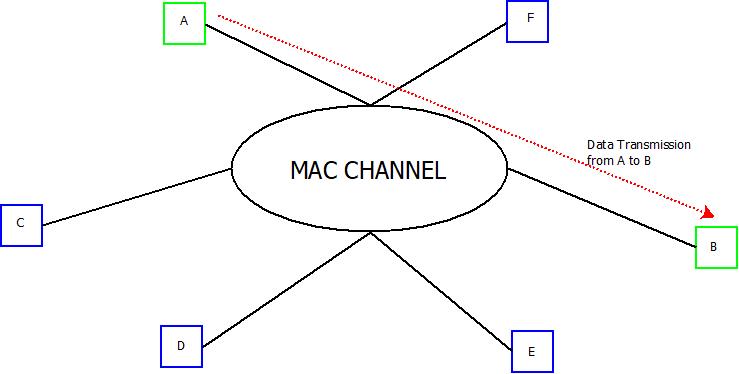Multiple Access Control : Introduction
- Multiple access control, as the name suggest is a channel that is shared among all its multiple respective
- Whenever any transmission between the two mobile nodes occurs, this shared multiple access control channel is used.
- For Example : A packet needs to be transmitted from mobile node “A” to mobile node “B”. In order to send the packets, a transmission channel is required. This transmission channel is called as MAC, which ensures that packet is delivered successfully from node “A” to node “B” irrespective of number of mobile nodes attached to it.

Multiple Access Control : Introduction
- As sharing a single channel results in lower operational cost but high chances of issues such as collision as that might be a possibility of data transmission from “A” to “B” and “E” to “D” at same time.
- Collision while data transmission is the major issue and can be resolved using the three collision detection and prevention protocols. These are:
- CDMA.
- TDMA.
- FDMA.
- Apart from collision, other issues also occur in MAC and that are known as issues in MAC channel.
Multiple Access Control : Issues
- Major issues that occur in MAC other than collision are:

Multiple Access Control : Issues
1. Mobility of Nodes
- This issue frequently occur while transmitting the data through MAC channel as any controlling while data is being exchanged among nodes might affect the mobility of nodes in its environment.
2. Hidden Terminal Issue
- Another issue that occur most frequently is the hidden terminal problem. The hidden terminal issue occurs when:
- Consider three mobile nodes sharing a single MAC channel then:
- “A” & “B” and “B” & “C” can transmit data to each other but “A” is not in the range to connect to “C” and “B” is the common node of transmission between “A” and “C”.
- At a particular time, if “A” sends data packets to “B” and “C” sends data packets to “B” collision will occur and this problem of non-coordination among the nodes is known as hidden terminal issue. Here, “A”, “B” & “C” are mobile nodes/devices.

Multiple Access Control Issues : Hidden Terminal Problem
3. Exposed Terminal Problem
- Exposed terminal problem arise when, for an on-going data transmission between two nodes and other nodes want to share the data but due to unavailability of information of which nodes are currently in connect, data transmission does not occur even if the other nodes are free.
- The problem is:
- “A” and “B” are transmitting the data.
- “A” can transmit data to “B” only and “C” wants to wants to share the data to “d”, it might not be able to share data to “D” because it might think that “B” & “D” are transmitting data but that will not be the actual case and it will result in prevention of data transmission and delay.

MAC Issues : Exposed Terminal Problem